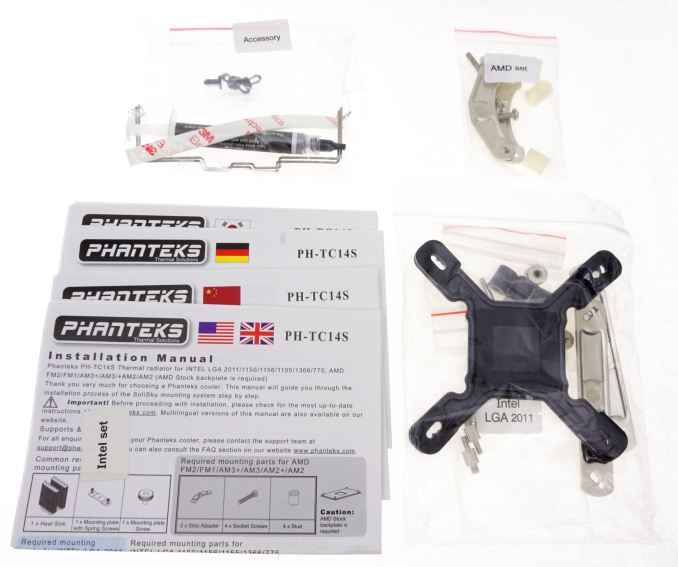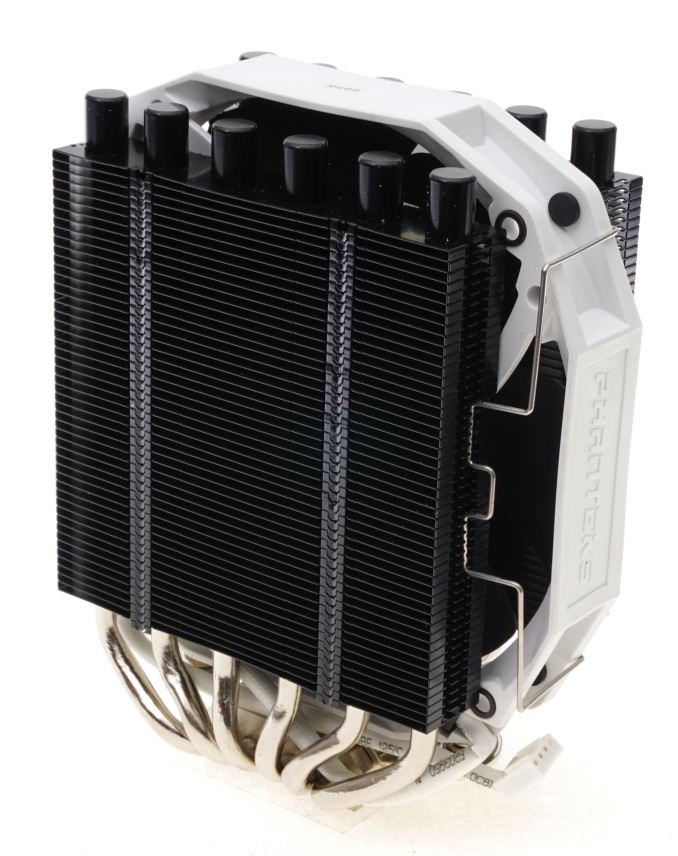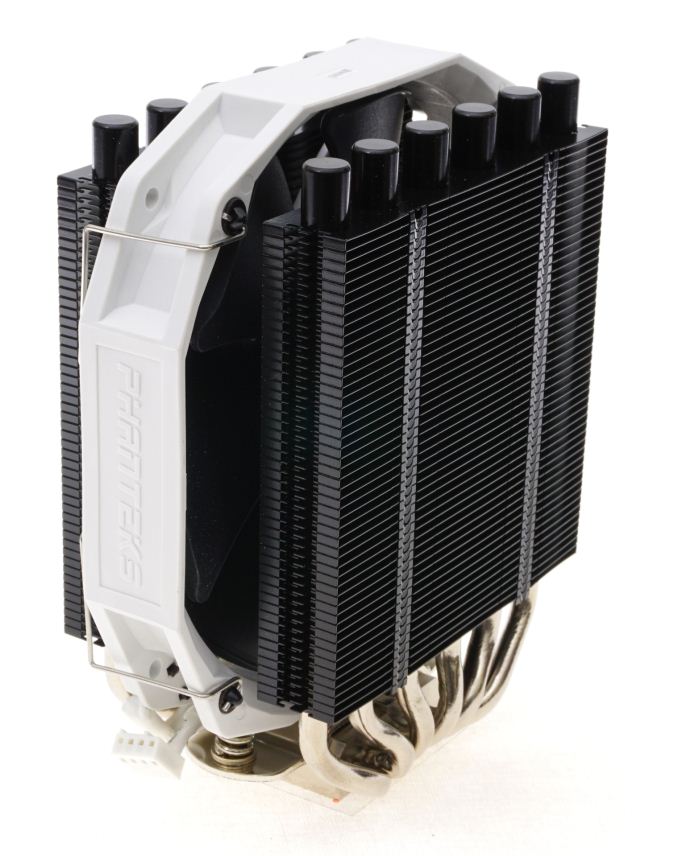The 140mm Slim Tower CPU Cooler Roundup: Thin & Light Done Just Right
by E. Fylladitakis on May 24, 2017 8:00 AM EST- Posted in
- Cases/Cooling/PSUs
- be quiet!
- Noctua
- Phanteks
- Cooler
- Thermalright
Phanteks PH-TC14S
Phanteks supplies the PH-TC14S inside a dark cardboard box with an abstract aesthetic theme, mostly based on schematic drawings of the cooler itself. It is not a very large box for a cooler that size, but it is very sturdy and the cooler is protected with polystyrene foam packaging, making it nearly impossible to damage during transport.
Inside the box we found four manuals, one for each of the most popular languages in the regions that the cooler is being marketed into, the necessary mounting hardware and a syringe with Phanteks PH-NDC thermal compound that should last for at least a couple of applications.
The Phanteks PH-TC14S is the “cheater” of this review, as it is not a single tower but a dual tower cooler design. It technically is a baby version of the monstrous PH-TC14PE that we had a look at a couple of years back. Still, this is Phanteks' only slim 140 mm tower cooler offering, and it is of comparable size to every other cooler in this roundup review. What the designers of Phanteks did was to split the single tower array into two very narrow arrays and place the 140 mm fan in between them. Strangely, the fins are significantly smaller than the fan without any apparent reason, meaning that there will be a significant loss of airflow to every direction.
The array fins are very thin and not strong individually, but they are soldered on the thick heatpipes that are only a few millimeters apart from each other. One major feature of the PH-TC14S is its black fins. Phanteks calls this paint job "Physical Antioxidant Thermal Shield" (or Physical Antioxidant Thermal Spraying - we found both in the company's texts) and claims that it enhances thermal performance by both increasing the dissipation rate of the heatsink itself and decreasing the radiation absorption rate from other heat sources. Unlike the PH-TC14PE, the PH-TC14S is available only in black.
The PH-F140HP fan also is a primary marketing focus of this product. It has the lowest RPM rating of every fan in this review (1300 RPM) but impressively high static pressure specifications (1.64 mm H2O at max speed).
Six thick heatpipes expand to either side of the small base. With the fin arrays placed in parallel, each heatpipe enters both arrays. Although that design appears very symmetric and effective at first, it actually does not appear to be optimal, as the two middle heatpipes that will be right above the CPU core and will be facing the bulk of the heat transfer enter near the fin arrays near the middle, where the fan’s airflow will be the lowest due to the dead spot under its motor.
The rectangular copper base of the PH-TC14S and the copper heatpipes are all nickel plated. Like with the majority of modern coolers, the base of the PH-TC14S is made of two parts, a copper contact plate and an aluminum top frame. The lower half of the base handles the thermal energy transfer away from the CPU and to the heatpipes, while the top half only offers mechanical cohesion and support for the steel mounting brackets. The nickel plated base is very smooth and machined down to a near-perfect mirror finish.
















74 Comments
View All Comments
Samus - Wednesday, May 24, 2017 - link
I think the thermalright cooler is pretty hard to ignore unless you are running a high-wattage CPU. Mild overclocks of a typical 80w CPU will make the thermalright the ideal solution at ~100w load, and also the quietest.Communism - Wednesday, May 24, 2017 - link
The problem with E. Fylladitakis 's style of testing is that they miss major factors in how the things tested actually function in relation to what they are made for.The reason why Noctua always does "better" in these synthetic tests is that they generally have a 100% flat contact surface.
The problem with 100% flat contact surfaces is that CPU IHS aren't anywhere close to 100% flat surfaces.
Most CPU IHS are concave, which is why Thermalright HSF always have convex contact surfaces.
Clamping pressure is also highly important, especially for Intel's non-soldered IHS CPUs.
Higher Clamping pressure both reduces the distance between the silicon and the IHS as well as forms a better mating between the IHS and the convex Thermalright contact surfaces.
These, and many other major factors that crop up in the real world make the 100% artificial testing like E. Fylladitakis conducts in actually have an extremely large margin of error, making them far less useful than the testing "scienciness" would lead you to believe.
fanofanand - Thursday, May 25, 2017 - link
If what you are suggesting is true, we should see Thermalright outperforming Noctua in every other publication's testing, correct? Most review sites (I believe all other sites actually) test CPU cooler performance on an actual CPU running tests, and more often than not inside of an actual computer case. Yet those same tests bring very similar results to what Anandtech has shown, which would appear to invalidate your entire postulation. How do you explain the lack of disparity between these other journalists' "real world" cases, and what Anandtech has done?Communism - Thursday, May 25, 2017 - link
Keep up your rhetorical questions.I don't know why I bother posting on this shill infested site anyways, waste of my time.
I'm not going to spoon-feed you for 20 posts like the forums.
I've spoonfed you for literally 100 posts before on the forums and your shill self has never acknowledged anything, making this a pointless conversation by any metric.
Have fun shilling with the other shills, adequate journalism in technology died quite a long time ago, and it shows.
Zetbo - Friday, May 26, 2017 - link
What a loser you are. When the data does not backup your point of view...you call everyone a shill! Thats the way to go! :DCommunism - Friday, May 26, 2017 - link
Took you a whole day to make another account?You really should get your pay docked.
Keep going and you're getting doxed.
fanofanand - Friday, May 26, 2017 - link
Doxx me big boy :)fanofanand - Friday, May 26, 2017 - link
Uh, I'm not on the forums, have you been taking mushrooms? I did read that they are the "least dangerous" psychadelics, but you seem to have overindulged. Apparently my point was irrefutable as you chose not to refute anything I wrote.BrokenCrayons - Friday, May 26, 2017 - link
The testing methods used in these HSF reviews are perfectly adequate because they remove a number of uncontrollable variables that would result from testing with PC hardware. The simulator equipment can produce repetable results with little to no variance between tests within AT's limited budget. I much prefer artifical tests as the basis for relative comparisons since the tests performed by other review sites won't accurately emulate my specific computing environment anyway and are therefore only useful as similarly relative comparisons. The science of these results appear trustworthy.WinterCharm - Thursday, May 25, 2017 - link
Funny how Thermalright performed better than Noctua at low and high fan speeds, then!